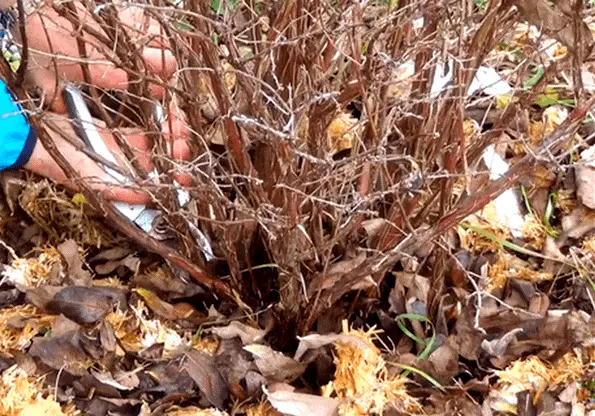Contents
- Description of Kamchatka honeysuckle
- Kamchatka honeysuckle varieties
- Honeysuckle Kamchatka Aurora
- Honeysuckle Kamchatka Borealis
- Honeysuckle Kamchatka Large-fruited
- Honeysuckle Kamchatka Boreal Bist
- Honeysuckle Kamchatka Boreal Blizzard
- Honeysuckle Kamchatka Blue Velvet
- Honeysuckle Kamchatka Balalaika
- Honeysuckle Kamchatka Sineglazka
- Honeysuckle Kamchatka Duet
- Honeysuckle Kamchatka Amur
- Honeysuckle Kamchatka Ruben
- Honeysuckle Kamchatka Kalinka
- Honeysuckle Kamchatka Zoyka
- Honeysuckle Kamchatka Icebar
- Honeysuckle Kamchatka Blue Dessert
- Honeysuckle Kamchatka Chernichka
- Planting honeysuckle Kamchatka
- Kamchatka honeysuckle care
- Reproduction
- Diseases and pests
- Conclusion
- Reviews of Kamchatka honeysuckle
Honeysuckle is traditionally very popular with gardeners, as it combines the properties of an ornamental plant and a berry bush. Currently, many varieties of this crop have been bred, and its cultivation has become possible not only in areas with a warm climate, but also in colder regions. One of its widely known varieties is Kamchatka honeysuckle, on the basis of which many productive varieties have been bred.
Description of Kamchatka honeysuckle
Kamchatka honeysuckle (Lonicera kamtschatica) grows naturally in the Far East, Primorsky Krai, Altai, Sakhalin, Kamchatka and the Kuril Islands.
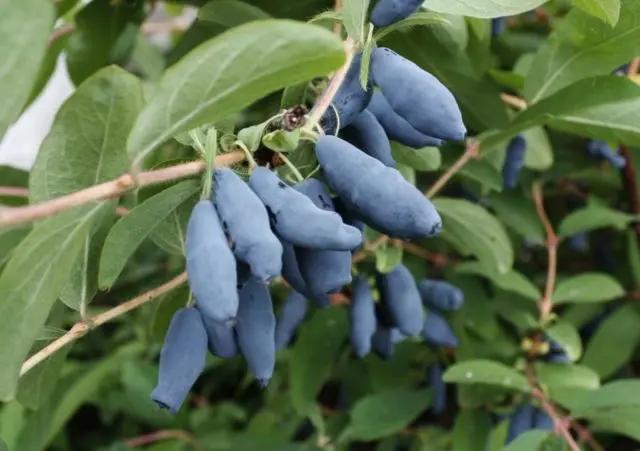
Edible fruits of Kamchatka honeysuckle are tasty and healthy
Here are the main characteristics of this plant:
Parameter | Value |
Type of plant | perennial deciduous shrub |
General view | Medium spreading strongly branched shrub up to 2 m high and up to 2 m in diameter |
Root system | Tree-like, strongly branched, strong, the largest number of roots is located at a depth of 0,2 to 0,4 m |
Shoots | Powerful, pubescent, young red-brown, bright, later dark brown, the bark on old shoots cracks and peels off in strips |
Leaves | Rounded-elongated, opposite, pointed, dark green with light veins, up to 7 cm long and up to 4 cm wide. At a young age, pubescent, as the leaf develops, the pubescence partially or completely disappears. Leaf plate of medium density, petioles of medium size. |
Flowers | Large, bell-shaped, drooping, light yellow, with long stamens |
Fruit | The berries are barrel-shaped, strongly elongated, up to 25-35 mm, blue, almost black, with a bluish wax coating on the surface. Ripen in June. |
Kamchatka honeysuckle varieties
Kamchatka honeysuckle was taken by breeders as a basis for breeding a large number of edible varieties, a description and photos of some of which are given in this article. The material is for informational purposes, more accurate information can be found in specialized literature.
A short video regarding the cultivation of Kamchatka honeysuckle can be viewed at the link:
Honeysuckle Kamchatka Aurora
Honeysuckle Kamchatka Aurora (Aurora) is a variety of Canadian selection. Derived from Solovey and Japanese MT46.55. It has been grown commercially since 2012.

The bush of the Aurora variety grows up to 1,8 m. It is dense, compact, slightly sprawling, consists of upright shoots. The fruits reach removable ripeness in the last decade of June, their average weight is 1,8-2,2 g. At the same time, up to 1-5 kg can be obtained from 6 bush. The fruits have a sweet taste.
Honeysuckle Kamchatka Borealis
Honeysuckle Kamchatka Borealis was bred by specialists from the University of Saskatchewan (Canada) as a result of cross-pollination of varieties Kyiv 8 and Tomichka. The plant forms a fairly compact bush 1,2-1,4 m tall. The foliage of the shoots is average. Self-infertile variety, requires pollinators.
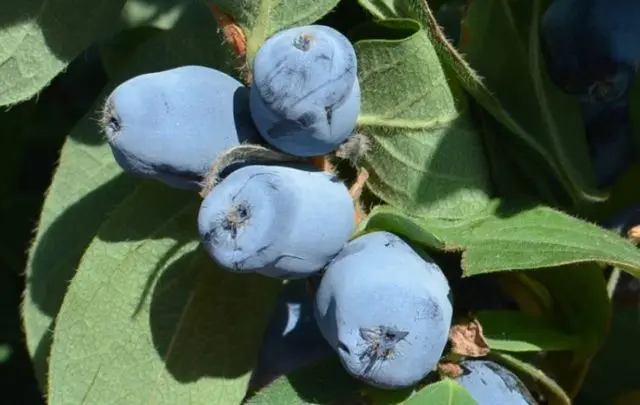
The fruits are blue, with a bluish wax coating, round-cylindrical, with an average weight of about 1,6 g. The flesh is red, quite juicy, sweet. Fruiting occurs from the middle to the end of summer, the yield can reach up to 4,5 kg from 1 bush. Berries sit firmly, do not crumble.
Honeysuckle Kamchatka Large-fruited
Honeysuckle Kamchatka large-fruited was bred by specialists of the domestic breeding school. A bush of an obverse-conical shape, up to 1,8 m in height and about the same in diameter, dense, strongly thickened.

The berries are elongated, bluish-blue, sweet and sour in taste. Ripens in mid-summer. The crumbling is average. For fruiting, this variety of Kamchatka honeysuckle requires the presence of pollinators.
Honeysuckle Kamchatka Boreal Bist
Boreal Bist is a relatively young variety of Kamchatka honeysuckle, bred at the University of Saskatchewan only in 2016. In a short time, it became famous and gained popularity due to the fact that it is very well suited for mechanized harvesting. The bushes of this variety are dense, up to 1,5 in height, the shoots are strong, thick.

The variety belongs to late, bears fruit from late July to September. Berries of a wide oval shape, black-violet, with juicy fleshy pulp. The taste is sweet, with sourness. The berries hold well on the branches, almost do not crumble.
Honeysuckle Kamchatka Boreal Blizzard
Honeysuckle Kamchatka Boreal Blizzard is another product of the selection work of specialists from the University of Saskatchewan (Canada). The variety was bred in 2016 based on the genomes of and Japanese varieties of edible honeysuckle. Belongs to late, bears fruit in August-September.
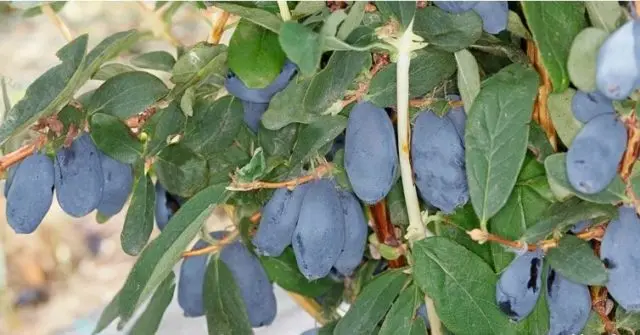
The bush forms a medium spreading crown, the height of which can reach up to 1,5 m. The stems are straight, powerful. The berries are blue, dark, oval, with juicy sweet pulp. Their average weight is 3-3,5 g, from 1 bush you can get 4-5 kg. This variety is sensitive to lack of moisture, but has excellent frost resistance. Flowers can withstand frosts down to -8 ° C, and the bushes themselves – up to – 40 ° C.
Honeysuckle Kamchatka Blue Velvet
The Kamchatka honeysuckle variety Blue Velvet was bred by Polish breeders. The bush has a medium spreading oval crown up to 1,7 m tall, consisting of numerous straight shoots of medium thickness. The leaves are greenish-gray, velvety to the touch.

The variety belongs to the early ones. The berries ripen in early July or a little earlier. Numerous dark blue fruits have an elongated shape, their weight usually ranges from 1-1,5 g. The total yield is up to 6 kg from each bush.
Honeysuckle Kamchatka Balalaika
Honeysuckle Kamchatka Balalaika is a low bush with a dense crown about 1,5 high and 1-1,5 m in diameter. It is considered high-yielding. The berries are numerous, cylindrical, light blue, ripen in July or a little later.
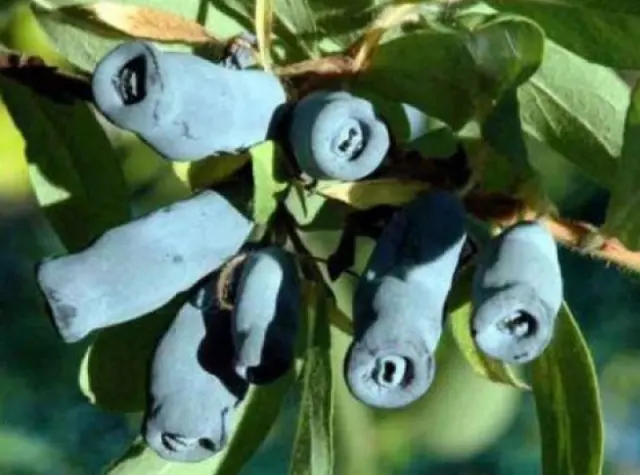
The variety is bisexual, is partially self-fertile. However, for abundant fruiting, the presence of pollinators is a must. Berries can be processed into any home canning products or eaten fresh.
Honeysuckle Kamchatka Sineglazka
The Kamchatka honeysuckle variety Sineglazka was bred by specialists in 1992. Crown up to 1,5 m high, rounded, with powerful straight shoots of reddish-brown color with a waxy coating. They are densely covered with oval-elongated, slightly pointed, bright green leaves that often fade in full sun.

Dark blue fruits with a bluish bloom appear on the branches quite early, already in early June. Each oval-elongated berry has a mass in the range of 0,7-0,95 g. The purpose is universal. From 1 bush is usually collected from 1,5 to 2 kg.
Honeysuckle Kamchatka Duet
Honeysuckle Kamchatka Duet was bred in the middle of the last century in Poland. The plant is a low rounded sprawling bush up to 1,1 m high and with a crown diameter of 1,2-1,5 m. The shoots are strongly pubescent, numerous, of medium thickness, curved. When young, they are greenish-beige, and later red-brown. The leaves are elongated, rounded, with a sharp tip, bright green, pubescent.

Honeysuckle Kamchatka Duet refers to the early ripening. It begins to bear fruit already at the very beginning of summer, and sometimes a little earlier. The fruits are round, fusiform, dark blue with a bluish bloom. The taste is pleasant, sweet, with a slight bitterness. The average weight of berries is 1,5-2,2 g, and the total yield from 1 bush can reach up to 3,5-4 kg.
Honeysuckle Kamchatka Amur
The Amur variety is a product of the German breeding school. The bush consists of powerful upright red-brown shoots up to 2 m high. The foliage is medium. The leaf plate is narrow, long, rounded, dark green.
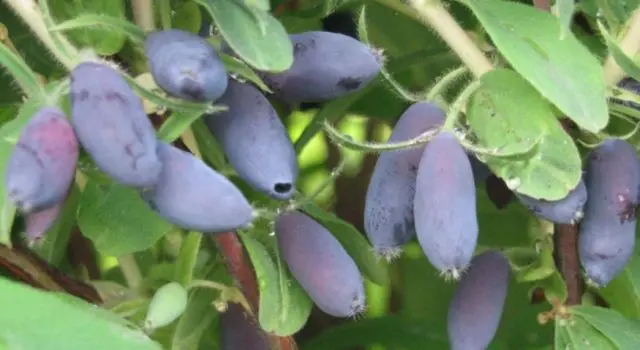
The variety belongs to the early, fruiting begins at the very end of spring. The berries are spindle-shaped, rounded, dark purple, covered with a matte bluish bloom. Their weight is usually in the range of 1,5-1,8 g, and the total weight of berries taken from 1 bush can reach 3-3,2 kg. The variety is self-fertile and requires the presence of pollinators for good yields.
Honeysuckle Kamchatka Ruben
Honeysuckle Kamchatka Ruben is a medium spreading bush about 1,5 m tall. Shoots are erect, strong, yellowish-brown with a reddish tinge. The leaves are oval-elongated, dense. Honeysuckle Kamchatka Ruben belongs to early ripe varieties. The first fruits reach technical ripeness in early June.

The berries are dark blue, weighing up to 1,3 g. The crop ripens amicably, while ripe berries almost do not crumble.
Honeysuckle Kamchatka Kalinka
The variety of Kamchatka honeysuckle Kalinka belongs to the early ripe ones. The plant is a dense, slightly sprawling shrub up to 2 m high and 1,2-1,5 m in diameter. The shoots are light brown, quite powerful, darken with age and acquire a reddish tint. The leaves are oval-elongated or ovate, with short petioles.
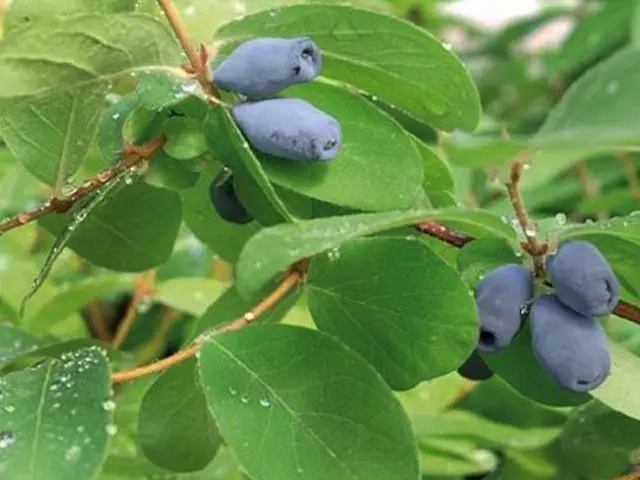
The fruits are dark blue with a bluish wax coating, cylindrical, round-elongated, weighing about 1 g. Fruiting begins in June. From 1 bush, under good conditions, it is possible to collect about 1,5 kg. The taste of fruits is sweet with pronounced sourness, pleasant. The purpose of the fruit is universal. Pollinators are required to produce a crop, as the variety is self-fertile.
Honeysuckle Kamchatka Zoyka
Honeysuckle Kamchatka Zoyka is a vigorous, rounded shrub about 1,6 m high and with a crown circumference of 1,2-1,3 m. Shoots are light brown, with a reddish tinge, hairless. The leaves are dark green, round-elongated, almost oval.
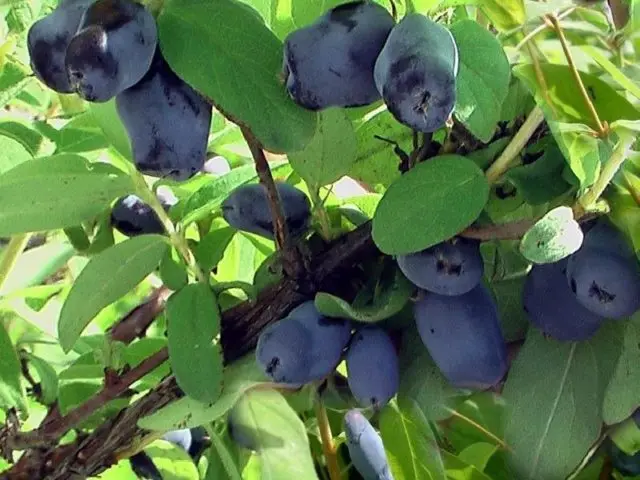
Fruiting is friendly, occurs in mid-June. The berries are oval-elongated, dark blue, have a light wax coating, weight is about 1 g. The taste is sweet and sour, moderately tart. The indicators of shedding are average. The variety is winter-hardy, has an increased resistance to fungal diseases.
Honeysuckle Kamchatka Icebar
Icebar, or Eisbar (Eisbar) – a variety of Kamchatka honeysuckle of Czech selection. It is a rounded shrub with a spreading crown about 1,5 m high and 1,2 m wide. The shoots are reddish-brown, of medium thickness and foliage. The leaves are oval-elongated, slightly pointed, green.
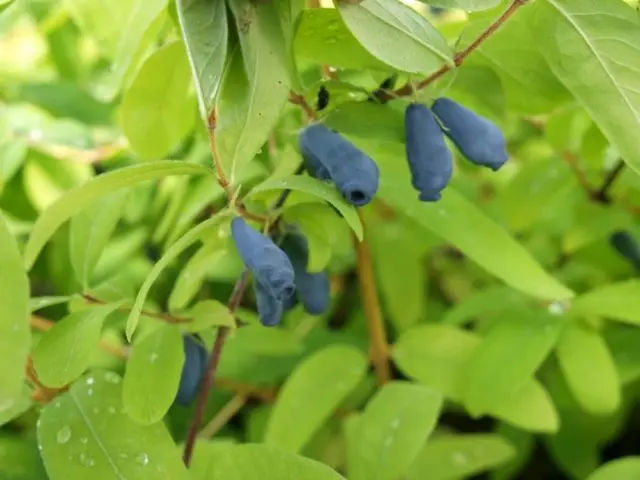
Fruiting occurs in June. The berries are dark blue, elongated, there is a bluish wax coating on the surface. The average fruit weight is about 1 g. The variety is self-fertile, the crop can be obtained only if there is another type of honeysuckle in the neighborhood, which will become a pollinator.
Honeysuckle Kamchatka Blue Dessert
The variety is the result of the selection work of the specialists of the Federal Scientific Center. I. V. Michurina (Our Country). In 2005, it was included in the State Register. A medium sized shrub with an oval crown shape. Shoots are erect, slightly pubescent, grow up to 1,5 m. The leaves are lanceolate, green.

The fruits are round-elongated, blue with a bluish bloom, weighing 0,7-0,8 g. The total collection from 1 bush under good conditions can reach up to 3 kg. Fruits of universal purpose, sweet with a slight sourness. Pollinators are required to produce crops.
Honeysuckle Kamchatka Chernichka
This type of Kamchatka honeysuckle was bred in the Urals in the 80s of the last century as a result of free pollination of seedlings of the Smolinskaya variety. The bush reaches a height of 1,5 m, but at the same time it is quite compact. The shape of the crown resembles an inverted cone. Shoots are straight, powerful. The leaves are lanceolate, light green, small.
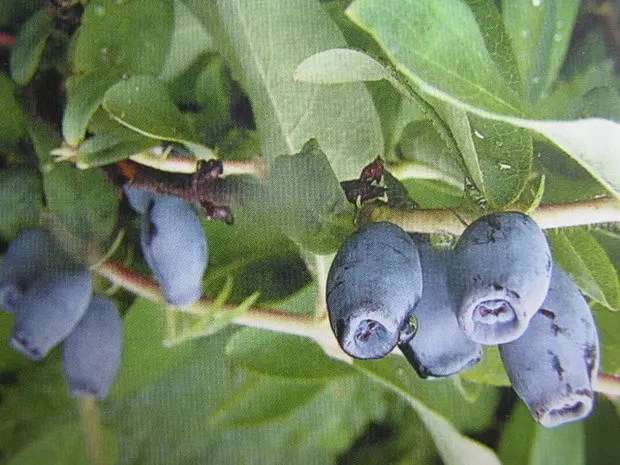
The yield of the variety is above average, from 1 bush they usually get 2-2,5 kg of purple, with a thin bluish bloom, berries weighing about 1 g. A distinctive feature of this variety is the taste of fruits, which really resembles blueberries. The variety is self-fertile, and a pollinator plant must be planted next to it in order to bear fruit.
Planting honeysuckle Kamchatka
When planting this shrub, special attention should be paid to the choice of location. Kamchatka honeysuckle tolerates transplantation well, especially at a young age, but it is much better if the plant is immediately planted in a permanent place. It is better to choose a sunny site; in the shade, honeysuckle bears fruit much worse. The soil should be loamy with a neutral level of acidity; on too acidic or carbonate lands, the plant will be weak, and the harvest will be poor.
Kamchatka honeysuckle is usually planted with seedlings. You can buy them in specialized stores or via the Internet. When planting, it should be borne in mind that most varieties of this plant are self-fertile and require the presence of pollinators. To get a decent harvest, you need at least 3 bushes, preferably different varieties. Kamchatka honeysuckle seedlings are sold in containers filled with nutrient soil. At the same time, their root system is closed. Transplantation of such plants is carried out together with a clod of earth.
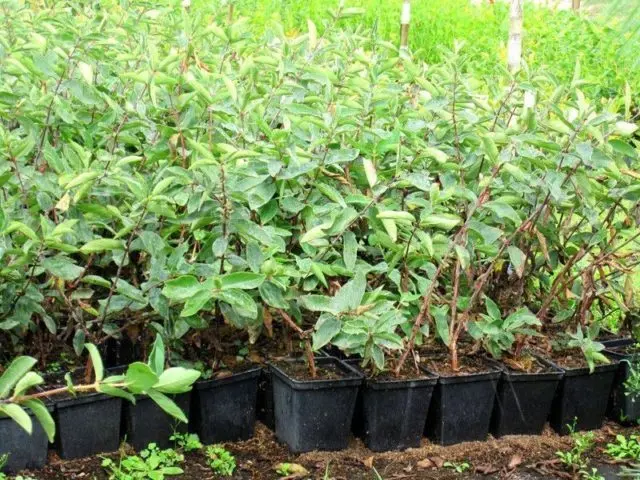
Kamchatka honeysuckle seedlings are usually sold in containers.
Any time of the year is suitable for planting Kamchatka honeysuckle with ZKS, with the exception of winter. If the root system is open, then planting can be carried out either in early spring, or at the end of summer or in autumn, after the end of the growing season. At the same time, the plant needs time to adapt to a new place, so all work is carried out no later than 1 month before the onset of frost.
The depth of the planting hole is calculated based on the volume of the root system of the seedling. It is usually enough to go deep by 0,4-0,5 m. For marshy areas, it is worth equipping drainage by adding a layer of expanded clay or gravel to the bottom of the pit. Be sure to add a bucket of compost or rotted manure to each hole – honeysuckle loves organic matter. It will not be superfluous to put a glass of wood ash in the planting pits, as well as a few tablespoons of superphosphate and any potash fertilizer. If all this is done in full, then the first few years the bushes will not need any additional feeding, which will allow them to actively grow and develop.
The very technology of planting a honeysuckle seedling is no different in Kamchatka complexity. The plant is removed from the container along with a clod of earth and placed vertically in a pre-moistened planting hole. After that, the pit is filled up, while the soil is periodically compacted to prevent the formation of voids. The root neck is not deepened, it should remain at the level of the soil. After filling the entire pit, intensive watering is carried out, and then the trunk circle is mulched with humus, which will prevent moisture from evaporating.
Kamchatka honeysuckle care
Further care for Kamchatka honeysuckle is simple. Here are its main steps:
- Watering. Should be regular, especially during the period of filling and ripening of berries. At least 10 liters of water must be poured under each bush, and if the weather is hot, then the watering rates should be doubled. However, the plant should not be flooded. Honeysuckle does not tolerate stagnant water in the roots, so you need to navigate the weather and compensate for the lack of atmospheric moisture in time for the bushes.

Watering honeysuckle should be regular, but moderate.
- Additional fertilizing. It is not necessary to fertilize up to 3 years – the bush is quite satisfied with those nutrients that were introduced during planting. So that the soil does not deplete, starting from 3-4 years, honeysuckle should be fed with organic fertilizers in the summer: compost, humus, rotted manure. If the shrub gives a weak increase, then in the spring it must be fed with nitrogen fertilizers.
- Trimming. Annually in spring and autumn, the shrub is inspected and dry and broken shoots are removed. In addition, periodically cut out the old branches on which the fruits cease to be tied. The maximum fruiting in Kamchatka honeysuckle occurs at the age of 7 years, so you need to strive for most of the shoots to be about this age. A bush with 15 to 20 skeletal branches of different ages is considered optimal.

In autumn, honeysuckle bushes need to be cleaned of dry and broken branches.
- Preparation for winter. Most varieties of Kamchatka honeysuckle have excellent frost resistance and are able to tolerate temperature drops down to -40 °C. No special measures are required in preparation for winter. Particularly caring gardeners cover the root zone of the shrub with a layer of humus, additionally protecting the roots from possible freezing.
Reproduction
Kamchatka honeysuckle can be propagated by seed or vegetative methods. In the first case, parental characteristics are not preserved, therefore it is not a fact that the same fruitful and sweet variety will grow from the seedling. For practical gardening, such methods of vegetative propagation as cuttings or dividing a bush are more applicable.

Green cuttings of Kamchatka honeysuckle root perfectly
Cuttings are a simple and affordable way to propagate the desired variety of honeysuckle. You can root cuttings several times during the season:
- End of March or beginning of April. Cuttings 15-17 cm long are cut from branches with a thickness of at least 7-8 mm. The lower cut is treated with a root formation stimulator and planted obliquely into the ground to a depth of about 10 cm so that 2 or more buds remain on top.
- After flowering. At this time, annual shoots with fresh growth can be used as cuttings. Cut branches are planted to a depth of 5-7 cm.
- End of June. At this time, green cuttings are used – the growth of the current year. They are cut with an apical bud and planted to a depth of about 10 cm. It is very important that the soil at the planting site is constantly moistened.
Another method of vegetative propagation of honeysuckle is the division of the bush. Such an operation can only be carried out with honeysuckle older than 8 years. A bush dug out of the ground is cut into several parts so that in each division there are at least 3 shoots and a part of the rhizome at least 0,4 m long.

Dividing the bush is a quick and effective way to propagate your favorite variety of honeysuckle.
Seedlings obtained in this way should be immediately planted in a new place.
Diseases and pests
Honeysuckle Kamchatka rarely gets sick. Her illnesses are mainly associated with the wrong choice of landing site, as well as with bad weather conditions and poor care. Below are the main diseases that can be found on this shrub.
Mučnistaâ rosa. One of the most common fungal diseases that affects plants in damp and cool climates. You can detect the disease by a whitish coating on the leaves, which quickly turn black and rot.

Affected parts of the plant must be cut and burned. For prevention, shrubs are sprayed with fungicides, for example, Bordeaux mixture.
Ramulariosis. This is a fungal disease that affects the leaves and shoots of plants, including honeysuckle. It can be recognized by rounded light brown spots with a dark rim on the leaf plate. In addition to damaging the crown, the fungus significantly reduces the frost resistance of the shrub.
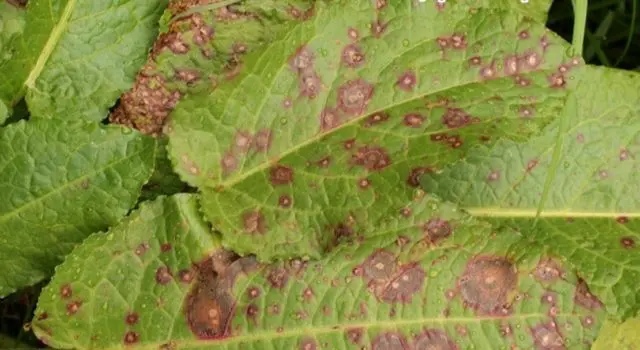
As with other fungal diseases, the treatment is to cut and burn infected shoots, as well as fallen leaves. For prevention, plants are sprayed with fungicides.
In addition to diseases, Kamchatka honeysuckle can also suffer from various pests. Among them, the following insects can be distinguished, presented below.
aphid. A common horticultural pest that parasitizes many plants, including honeysuckle. It is a small, shellless sucking insect that feeds on the juice of various crops. The aphid is extremely prolific, as a result of which its population is growing very rapidly.
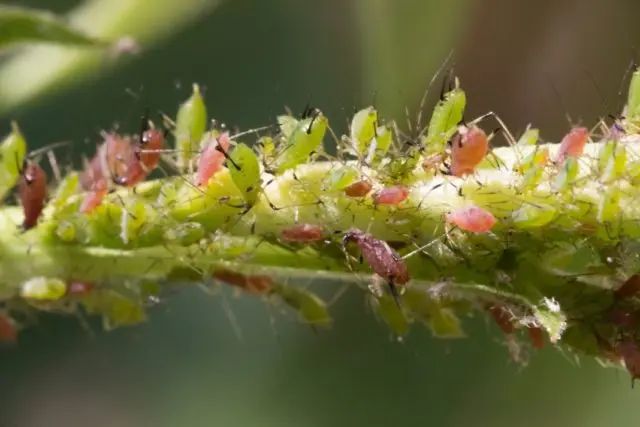
Aphids are dangerous in their abundance
To combat aphids, you can use a variety of drugs, including folk remedies, such as infusion of tansy, garlic, celandine or tobacco.
spider mite. It is a microscopic sucking insect often found on honeysuckle. You can determine its presence by twisted leaves and a cobweb braiding them.
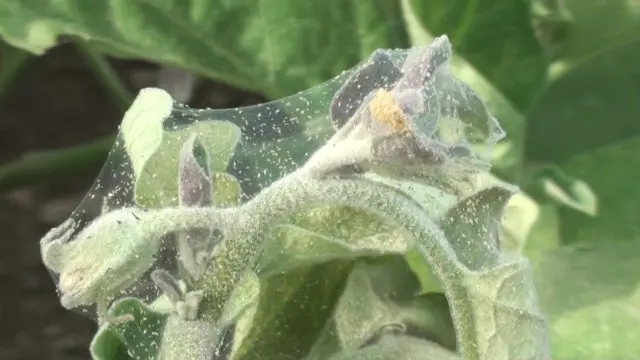
Cobwebs on leaves are a sign of mites.
To combat the tick, special means are used – acaricides, such as Fufanon, Aktellik and others.
In addition to these pests, on honeysuckle you can sometimes find various beetles, leafworms, moths and other insects, the larvae of which feed on the green mass of the plant. To combat them, various insecticides are used: Iskra, Inta-Vir, Karbofos, etc. The range of drugs used is very wide.
Conclusion
Kamchatka honeysuckle is not only a fruit shrub that gives tasty and very healthy berries, but also a good ornamental plant. In addition, this species is an excellent honey plant. All these qualities in combination give the right to say that planting Kamchatka honeysuckle on a personal plot is the right decision.











